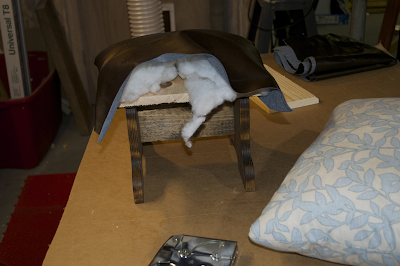My wife reads a lot of books. How many is a lot? Well, she wanted to read 52 last year and finished that many in about 5 months. I have seen wooden book rests in the past made out of wood,
here is a link to a few, and I figured it would be a nice thing to make for my wife. I didn't want to just make a simple triangle that served no purpose when not in use though. So I thought building a book house rather than a book rest would be better.
I had been wanting to use some of the pallet wood I had taken apart, but until I got a planer I didn't really have a way to make these boards nice and usable. So this project has been floating around in my head for about 5 or 6 months. Once I got the planer, these were the first boards planed to make the 5 sides of the book house.
Here are the rough boards before I planed them. They had quite a few imperfections and the large board had a slight cupping to it.
Here are the 3 boards after being planed down and jointed on the sides that are going to be glued together. You can see here that the middle board lost that red tint that it had. One step that I missed here and didn't realize until it was to late was to rip one of the side boards using the jointed side as a reference edge. So after the board was glued together, I had to just kind of wing it to get everything squared up.
The next step was to glue the boards together. I'm sure I probably overkilled it here a bit with the clamps, but I didn't want any of them to feel left out.
And here is what the board looked like after it was glued, cut down to size, and planed again.
There was a bit of planer snipe at the end of the board, you can kind of see the lines at the top of the board in this picture. I plan to make a better in-feed and out-feed table for the planer to address this.
On a side note, if anyone knows what kind of board the center one is leave a comment. I'm pretty confident that the right and left side pieces are Oak.
I cut the bottom and sides out of the board above on my table saw with my crosscut sled, then went over to the bandsaw to cut out the finger joints. I wasn't entirely happy with how the finger joints came out, as they are a bit loose. For the next set of joints I used a dado blade on my table saw.
Here are the rough boards I am going to plane and glue up to use for the top piece. It is going to be longer than I need, but I wont complain about having some left overs.
The board looks pretty good after being cut to length and planed down a bit.
The roof section here is cut a tad bit wide since I figured I would cut to the exact length after I had all of the pieces ready. Doing it this way will give me a bit of scrap that I can use to test finishing options as well as saving me the time of doing the math.
On the left you can see the base section being glued together and on the right is a closer shot of the top sides of the base. I ended up making a couple 45 degree angled cuts to give the roof somewhere to sit.
I don't have any pictures of gluing together the roof but it was a pretty simple clamp up being a 90 degree angle. The next step was to attach the roof to the house. Since I didn't have a good way to clamp this together, I ended up using ratchet straps. This seemed to work very good. As you can see on the left side where the roof meets the base its not quite square. I think this is partially due to my finger joints being a little sloppy.
After unstrapping the house and giving it a good sanding from 80 grit to 220 grit this is what it looks like. I intentionally put the knot and hole on the outside of the piece, my wife likes the look of those parts of the wood.
I tested some Tung and Danish Oil on a couple of the scraps from this project to see which would look better. They were pretty close in finish to be honest but the Tung Oil won out in the end.
This is what the finished product looks like after 2 coats of Tung Oil and a bit of sanding with some steel wool.
I took a few of my wife's books and threw them in the book house. I think this turned out pretty well.
The shot on the right is my favorite. I love the way the fingers look dark at the seam on top.





















































